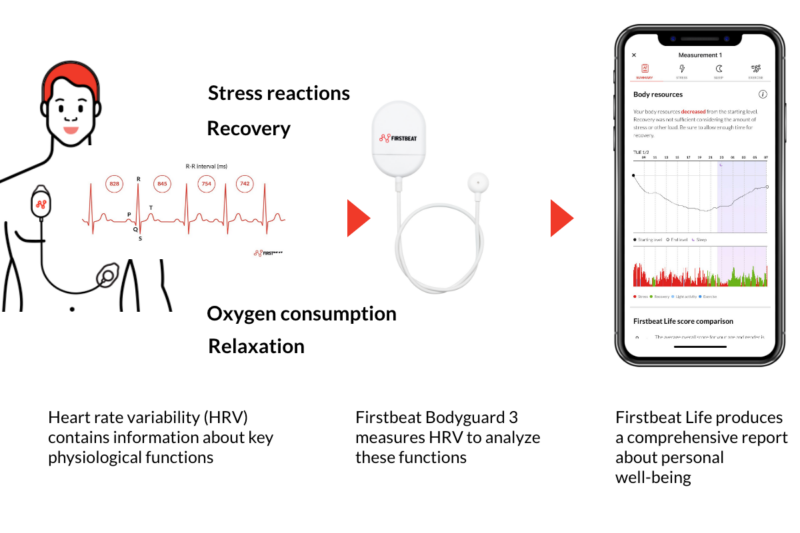
For more than two decades Firstbeat has been a pioneer in the use of physiological data and analytics to improve sports performance and employee well-being. We have always built our doings on data, and the reference level data has also been benefiting the scientific community in exploring different factors and phenomena related to human psychophysiology.
Today, there are already more than 300 scientific peer-reviewed academic research papers that have been published using Firstbeat’s methods and tools. The topics cover a wide variety of research areas from validations to applied use, from newborns to the elderly, from schools to working communities, from laboratories to playing fields, from Brazil to Tibet – even including some studies with wild mammals.
We have updated our research offering and are proud to serve our customers with the third generation of a state-of-the-art lightweight, electrode-based 24-hour heart rate variability device called Bodyguard 3. The device can be used for raw data collection or together with Firstbeat Sports or Firstbeat Life.

For researchers interested mainly in exploring the autonomic nervous system function with traditional HRV, it offers the RR-intervals with 1 millisecond accuracy. That data can be complemented with 3-dimensional acceleration data and single-lead electrocardiography and downloaded with a specific desktop application for PC or Mac.
For wellness-oriented research, Firstbeat Life offers new possibilities. With a mobile application, the participants can collect round-the-clock data for longer periods of time which can be beneficial in intervention type of study designs. Data collection can be handled remotely and easily by the participants. The available metrics include to mention a few, validated stress-related parameters [1], physical activity and physical workload evaluation with oxygen uptake and body movements modeling [2], and VO2max estimations shown to be feasible ways of evaluating cardiorespiratory fitness in real-life conditions using a walking test [3].
For sports and performance type of use, we deliver a chest strap sensor option shown to provide high-quality data [4]. Here the metrics extend from minimal to average to peak heart rates, time spent in different HR zones, and tracking HR recovery after drills or tests. For internal training load monitoring, EPOC, TRIMP, and Training Effect are key variables to explore [5]. Recovery monitoring has been shown to be beneficial in training guidance [6]. Movement Load, Movement Intensity, and Movement Intensity curve quantify the external strain and demands during training, games, and competitions [7].
Oxygen consumption, respiration rate, and energy expenditure remain at the center of exercise physiology, often utilized in the emergency services and police personnel as well as in military settings in assessing the load of tasks [8].
Both platforms (Firstbeat Sports and Firstbeat Life) offer data export functionality for convenient data collection and processing including access to time series data from RR-intervals to physiological metrics in seconds accuracy complemented with scalar variables over the measurements.
Technology can help us to take science from the lab to the field, increase the understanding of human physiology in different conditions and settings, and benefit the athletes and coaches to reach their goals and aspirations. In wellness, there are vast opportunities to investigate the psychophysiology of human beings, and how we behave, respond, and act. Heart rate variability-based methods also offer a window into the body for the research community.
Have you or your research institution used Firstbeat? Please, introduce yourself to the latest findings in our webpage’s science section and join our coming research webinar!
Interested in learning more about Firstbeat for your next research project?
Register now for our free webinar.
References
[1] Seipäjärvi et al. (2022). Measuring psychosocial stress with heart rate variability-based methods in different health and age groups. Physiological Measurement, 43 (5)
[2] Mänttäri et al. (2023). Increased physical workload in home care service is associated with reduced recovery from work. International Archives of Occupational and Environmental Health, 96, (5), 651-660.
[3] Rissanen et al. (2022). Cardiorespiratory Fitness Estimation Based on Heart Rate and Body Acceleration in Adults With Cardiovascular Risk Factors: Validation Study. JMIR Cardio 6(2):e35796
[4] Parak et al. (2021). Comparison of Heart Rate Monitoring Accuracy between Chest Strap and Vest during Physical Training and Implications on Training Decisions. Sensors, 21(24), 8411
[5] Benítez-Flores et al. (2021). Physiological and Psychological Responses to Three Distinct Exercise Training Regimens Performed in an Outdoor Setting: Acute and Delayed Response. Journal of Functional Morphology and Kinesiology, 6 (2): 44
[6] Nuuttila et al. (2017). Effects of HRV-Guided vs. Predetermined Block Training on Performance, HRV and Serum Hormones. International Journal of Sports Medicine, 38(12): 909-920.
[7] Portes et al. (2023). A Comparison of Training and Competition Physical Demands in Professional Male Basketball Players. International Journal of Basketball Studies, 2(1), 25-33.
[8] Nykänen et al. (2023). Energy Balance, Hormonal Status, and Military Performance in Strenuous Winter Training. International Journal of Environmental Research and Public Health, 20(5), 4086

If you liked this article, you should subscribe to our newsletter.
You might also be interested in

Optimizing Real-Time Athlete Monitoring Through Historical Data Analysis
This article is written by Domenik Theodorou, a Firstbeat Sports client and Performance Coach at RASTA Vechta, a professional basketball team competing in the Basketball Bundesliga (BBL). Prior to his…

The Need for Off-Season Non-Specific Conditioning
In this article, guest writer and Firstbeat client Konstantinos Stratakis discusses the role of off-season conditioning in team sports, including balancing sports-specific and non-specific conditioning like HIIT. He also explores…


